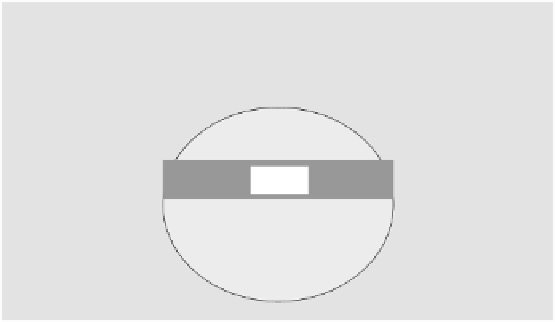Biomedical Engineering Reference
In-Depth Information
where ˛
1
and ˛
2
are constant parameters. For example, when proteins bind to the
sensing layer, the effective refractive index changes as
n
D
.n
2
C
2/
2
Œ.n
w
1/=.n
w
C
2/.V=V
tot
/
.n
2
1/=.n
2
C
2/.t=t/=6n; (2.84)
where n and V are the refractive index and volume, respectively, of the protein;
n
w
and V
w
are the corresponding parameters for water; and V
tot
D
V
C
V
w
.
The modification of the SPP resonance angle is expressed in resonance units
(RU): 10
3
RU corresponds to a change of this angle with 0.1 degrees caused by
biomolecules with a mass concentration of 1 ng=cm
2
immobilized on the sensing
layer.
The sensitivity of SPP sensors is defined as the first derivative of the monitored
parameter (angle, wavelength) with respect to the measured parameter (refractive
index, thickness, concentration, etc.). When the sensitivity is expressed as a change
in the angle of incidence as a function of the refractive index, it is measured in RIU
(refractive index unit). Typically, the sensitivity of SPP sensors excited in a prism
configuration is higher than of those based on gratings. The maximum resolution
obtained with these configurations is about 3
10
7
RIU, higher resolutions, of
the order of 10
8
10
9
, being achievable in an SPP sensor integrated with an
interferometer, for example, a Michelson interferometer (
Yuan et al. 2006
). New
trends in instrumental design for SPP-based biosensors are reviewed in (
Abbas
et al. 2011
).
SPP sensing of biomolecules, food quality, and environmental change is an area
with huge applications (
Shankaran et al. 2007
). For instance, the SPP immunosensor
is based on antigen-antibody recognition of various analytes, which is taking place
at the metal-dielectric interface and so changes the reflectivity curve of the SPP
sensor. An SPP immunosensor is displayed in Fig.
2.35
. This SPP sensor works in a
simple way, i.e., the antibodies are immobilized on the gold surface. Then, when an
microfluidic channel
antibody
antigen
Au film
chip
light
Fig. 2.35
The SPP immunosensor
































Search WWH ::

Custom Search